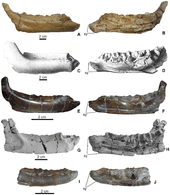Rhabdodontidae
| Rhabdodontidae Temporal range: Cretaceous, 106–66Ma | |
|---|---|
 | |
| Rhabdodon priscus | |
| Scientific classification | |
| Kingdom: | Animalia |
| Phylum: | Chordata |
| Clade: | Dinosauria |
| Order: | †Ornithischia |
| Clade: | †Ornithopoda |
| Suborder: | †Iguanodontia |
| Family: | †Rhabdodontidae Weishampel, 2003 |
| Genera | |
Rhabdodontids were herbivorous ornithopod dinosaurs from the Cretaceous Period. Rhabdodontids were similar to large, robust "hypsilophodonts", with deep skulls and jaws. The family was first proposed by David B. Weishampel and colleagues in 2002. The rhabdodontids were defined as "the most recent common ancestor of Zalmoxes robustus and Rhabdodon priscus and all the descendants of this common ancestor". In 2005, Paul Sereno defined the family as "the most inclusive clade containing Rhabdodon priscus but not Parasaurolophus walkeri".[1] The Rhabdodontidae includes the type genus Rhabdodon, Zalmoxes, Mochlodon and possibly Muttaburrasaurus.[2] Rhabdodontid fossils have been found in Europe and Australia in formations dating from the Early to Late Cretaceous, 100 to 66 million years ago. Ősi et al. (2012) proposed that Rhabdodon underwent gigantism on the mainland, as opposed to Zalmoxes and Mochlodon experiencing nanism on island habitats.[3] In 2013, Darren Naish discovered a tiny rhabdodont tibia from Sebeș, Romania, turning out to be the smallest known; a paper (Brusette et al 2013.) later in the same year identified it as Zalmoxes, cf. Z. shqiperorum.[4]
Classification

The Rhabdodontidae is a group of ornithopod dinosaurs, occupying family rank in linnean classification. See individual sections for more information.
Relationships
The Rhabdodontidae are a group of ornithopod dinosaurs (See Ornithopoda, Ornithischia and Dinosaur articles for more inclusive information.), more specifically some of the basalmost iguanodonts. Most analyses find them to be more derived then Tenontosaurus but more basal then Elasmaria, Dryosauridae, Camptosaurus, and more advanced Iguanodonts. Where the cut off line for rhabdodontidae is different depending on definition (See below.).
Inclusion
As stated above, there are differing opinions as to the constituents of Rhabdodontidae. The original definition, the last common ancestor of Zalmoxes robustus and Rhabdodon priscus, would not include Muttaburrasaurus, as well as many other hypothetical rhabdodonts that would have existed during the ghost lineage. The definition by Sereno, the most inclusive clade containing Rhabdodon priscus but not Parasaurolophus walkeri, would include the entire ghost lineage, and Muttaburrasaurus. This ghost lineage lasts 90 million years without Muttaburasaurus, and is still quite long including it, as it is the only rhabdodont known from such an early time (106 Ma).
Phylogeny
Most phylogenetic analyses recover the two Zalmoxes species and two Mochlodon species to be sister taxa, with Rhabdodon as the sister taxon to that clade (Ősi et al. 2012; McDonald 2012a).[3][5] Multiple analyses also find Muttaburrasaurus to be the sister taxon to all other rhabdodontids, including McDonald (2012a), and McDonald et al. (2010).[5][2] The left genus-level cladogram is from an analysis by McDonald et al. (2010), including all possible rhabdodontids:[2] The right cladogram shows a Rhabdodontidae not including Mochlodon, found by McDonald (2012a):[5]
|
|
The left cladogram is from Osi et al. (2012) and excludes Muttaburrasaurus from Rhabdodontidae:[3] The right cladogram is from Weishampel et al. (2003) and excludes Mochlodon and Muttaburrasaurus from Rhabdodontidae:[6]
|
|
List of known Rhabdodontids
The below list includes all currently known rhabdodontids, and follows McDonald et al. (2010):[2]
- Rhabdodon
- R. priscus
- R. septimanicus
- R. sp.?
- Zalmoxes
- Z. robustus
- Z. shqiperorum
- Mochlodon
- M. suessi
- M. vorosi[3]
- Muttaburrasaurus[5]
- M. landoni
- M. sp.
Note that undetermined Rhabdodon material from France and the Czech Republic respectively, currently referred to as R. sp., have on occasion been suggested to be distinct species. However, the Czech material has also been suggested not to be diagnosible to Rhabdodon specifically, and if found to be a new species, it may belong in a separate genus.
References
- ↑ Sereno, P.C. (2005). "Stem Archosauria Version 1.0." TaxonSearch. Available: http://www.taxonsearch.org/Archive/stem-archosauria-1.0.php via the Internet. Accessed 24 November 2010.
- ↑ 2.0 2.1 2.2 2.3 McDonald, A.T., Kirkland, J.I., DeBlieux, D.D., Madsen, S.K., Cavin, J., Milner, A.R.C. and Panzarin, L. (2010). "New Basal Iguanodonts from the Cedar Mountain Formation of Utah and the Evolution of Thumb-Spiked Dinosaurs." PLoS ONE 5, 11: e14075. doi:10.1371/journal.pone.0014075 PMID 21124919
- ↑ 3.0 3.1 3.2 3.3 Ősi, A.; Prondvai, E.; Butler, R.; Weishampel, D. B. (2012). Evans, Alistair Robert, ed. "Phylogeny, Histology and Inferred Body Size Evolution in a New Rhabdodontid Dinosaur from the Late Cretaceous of Hungary". PLoS ONE 7 (9): e44318. doi:10.1371/journal.pone.0044318. PMC 3448614. PMID 23028518.
- ↑ Brusette et al (2013): AN INFANT ORNITHOPOD DINOSAUR TIBIA FROM THELATE CRETACEOUS OF SEBEŞ, ROMANIA
- ↑ 5.0 5.1 5.2 5.3 Mcdonald (2012a): Phylogeny of Basal Iguanodonts (Dinosauria: Ornithischia): An Update
- ↑ Weishampel, D.B.; Jianu, C.M.; Csiki, Z.; Norman, B.D. (2003). "Osteology and phylogeny of Zalmoxes (n.g.), an unusual Euornithopod dinosaur from the latest Cretaceous of Romania" (PDF). Journal of Systematic Palaeontology 1 (2): 65–123. doi:10.1017/s1477201903001032.